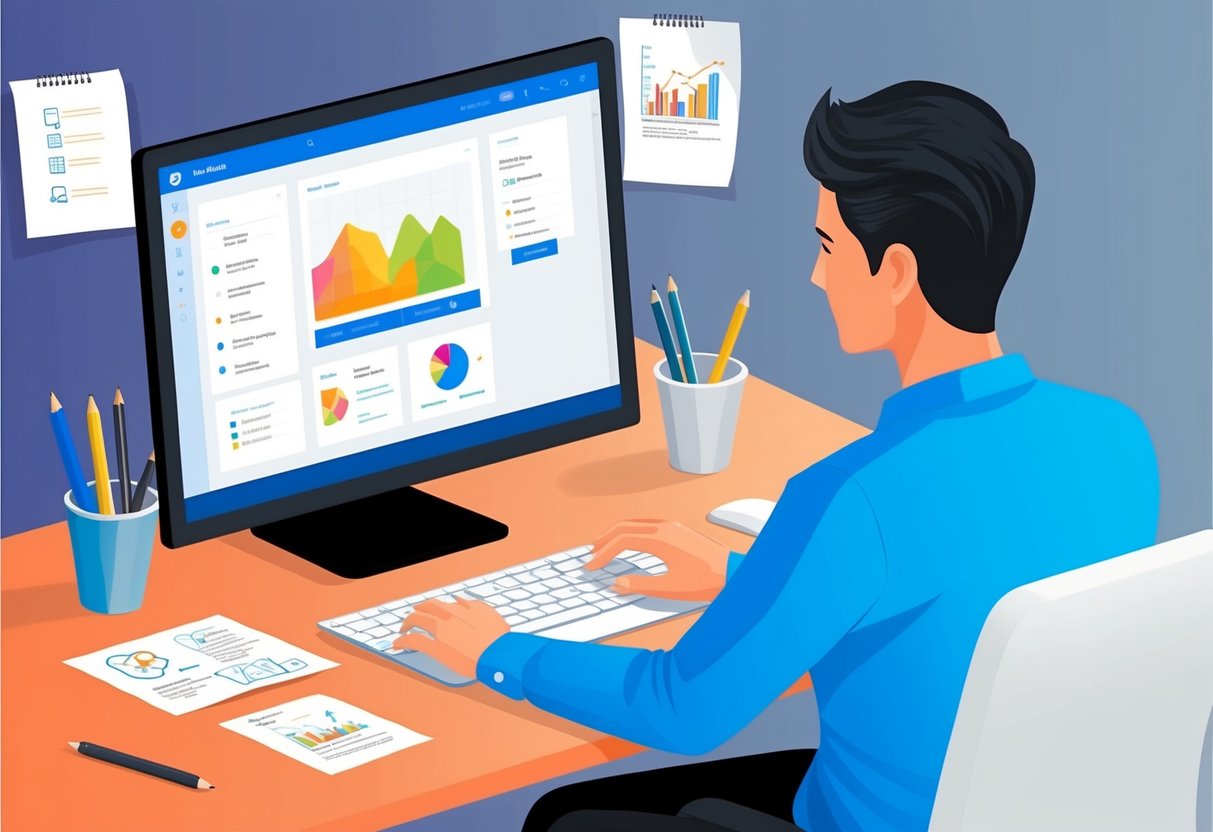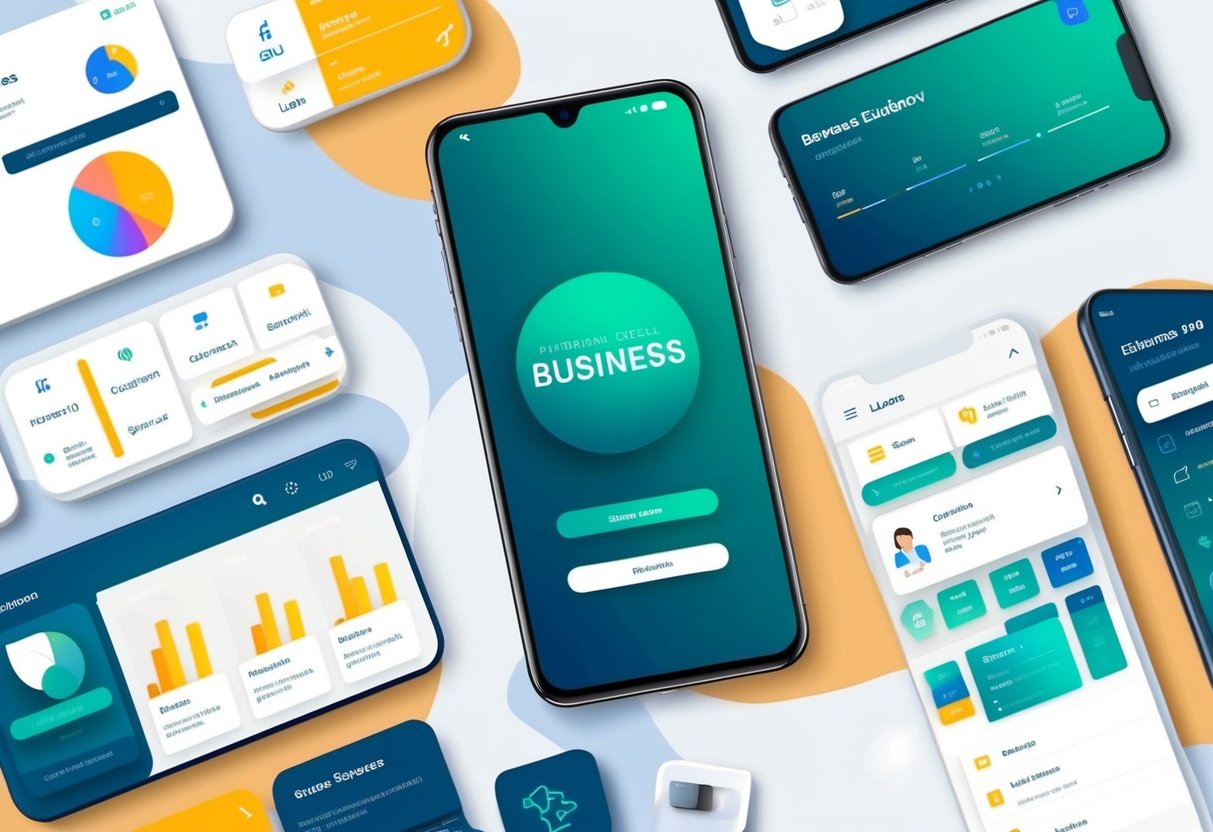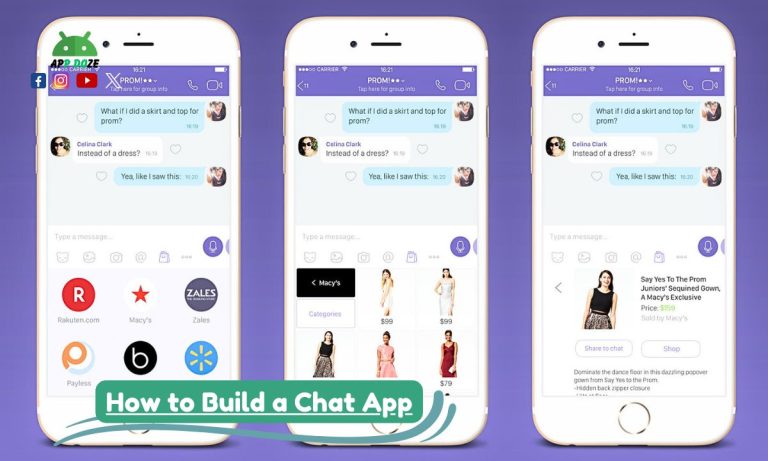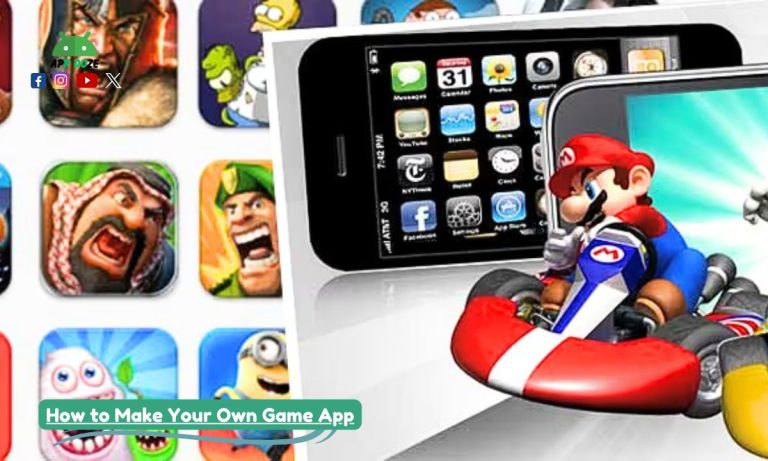A business app is a software application that helps you run your business more smoothly. It can be a mobile app or a web-based tool that helps with different tasks like managing customers, handling orders, tracking sales, or even accepting payments. Whether you’re running a small shop or a large company, a business app can make your daily work easier and more organized.

In today’s digital world, people expect fast service, easy communication, and smooth processes. If you don’t have a business app, you might miss out on many chances to grow. A business app can help you connect with your customers, keep your team on track, and even increase your sales. That’s why every business, big or small, should consider having one.
This guide will help you understand how to make a business app, step by step. Even if you have no coding experience or don’t want to spend a lot of money, there are simple and free ways to get started. You’ll also learn how to make a business app free using no-code tools or affordable platforms, and how to get a business app built that matches your needs.
Types of Business Apps You Can Create
Before you start building your app, it’s important to know the type of business app you want to create. Each app type serves a different purpose, depending on your business goals. Here are the main types you should know about:
Small Business App
If you run a small business, you probably deal with daily tasks like handling customer orders, scheduling appointments, or managing inventory. A small business app can help you do all of this in one place. You can create a simple app where customers can book your services, place orders, or contact you directly. Learning how to make a small business app is a great first step if you’re just starting and want something easy to manage.
Commercial App
A commercial app is designed for companies that want to sell products or offer services on a larger scale. If you have a store, an eCommerce business, or provide any kind of professional service, this type of app helps you reach more customers. You can showcase your products, take payments, offer discounts, and manage your orders. Knowing how to make a commercial app can really take your business to the next level, especially if you’re looking to grow online.
Cash App (Finance or Payment Focused)
This type of app is useful if your business deals with money transfers, customer payments, or digital wallets. For example, if you want to create an app that lets users send or receive money, track payments, or split bills, this is the kind of app you need. Many people are searching how to make a business cash app because it’s a popular feature in today’s market. You can build a simple version using no-code platforms or explore advanced options if you’re planning a full-scale payment app.
Business Software App (Management Tools)
This kind of app is focused more on internal operations like chat apps. If you manage a team or need tools for project tracking, employee management, or reporting, then you need a business software app. These apps are like mini management systems that help you keep everything organized. Learning how to make a business software app can help you save time and reduce manual work, especially if you’re handling many tasks at once.
Understanding the type of app that suits your business is the first step. It helps you choose the right tools, design, and features for your goals. Once you decide what kind of app you want, the rest of the process becomes much easier.
What You Need Before You Start
Before you begin building your business app, it’s important to prepare a few basic things. This will save you time later and help you stay focused during the process. Whether you plan to build the app yourself or hire someone, having a clear plan makes everything easier.
Your Business Idea or Goal
Start with your idea. Ask yourself why you want to make this app. What problem does it solve? What is the main goal of the app? Maybe you want to increase sales, offer better customer service, or make it easier for people to book your services. When your goal is clear, the whole app-building process becomes simple and straight.
Who the App Is For (Target Users)
Think about who will use your app. Are they your customers, your employees, or both? Are they young people who like fast apps, or business owners who need detailed tools? Understanding your target users helps you create a better experience for them. If the app is easy to use and helpful, people will keep coming back.
Features You Want (Login, Chat, Payment, etc.)
Now think about the features your app should have. Make a list of the things you want inside your app. Some common features include:
- Login or sign-up page
- Chat support or customer messages
- Online payments
- Order tracking
- Booking system
- Product or service listings
Try to keep it simple at the start. You can always add more features later once your app is working well.
Budget: Free Tools vs Paid Development
Next, decide how much money you want to spend. If your budget is low or zero, you can still create a good app using free or low-cost tools. But if you want a custom app with advanced features, you may need to spend more.
Here’s a simple comparison to help you choose:
| Option | Cost Range | Best For |
|---|---|---|
| Free No-Code Tools | $0 to very low | Beginners, testing ideas, small projects |
| Low-Cost Builders | $10 to $50/month | Small businesses with simple features |
| Freelance Developers | $300 to $2000+ | Custom apps, special business needs |
| App Development Agencies | $2000+ | Full control, large business apps |
Choose what fits your business goals and budget. You can start with a free tool, and if your app grows, upgrade later to something more powerful. Planning this from the start helps you avoid stress and unexpected costs.
How to Make a Business App (Step-by-Step Guide)
If you are ready to build your business app, this step-by-step guide will help you move in the right direction. Whether you want to create a business app for free or hire someone to develop it for you, these steps are useful for both options. Just follow each step and stay focused on your goal.
Step 1: Choose Your App Type
Start by deciding what kind of app you want to make. This depends on your business model and what you want the app to do. Do you need a small business app to manage your orders? Do you want a cash app that handles payments and money transfers? Or are you thinking of building a full business software app for team management?
Knowing your app type will make it easier to choose features and design later. You don’t need to overthink it. Just ask yourself what you want your app to do, and pick the type that matches your goal.
Step 2: Pick the Right Platform
Next, you need to choose where your app will run. There are three main options:
- Android (Google Play Store)
- iOS (Apple App Store)
- Web (browser-based apps)
If your audience is mostly Android users, go for Android first. If you want people to use the app on both iPhones and Android phones, you can build a cross-platform app. Web apps are a good choice if you want users to access your service from laptops or desktops.
The platform you choose will also affect your design, features, and even your budget.
Step 3: Decide Your Budget
Now think about how much money you can spend. If you want to keep costs low, you can create a business app for free using no-code tools. These platforms give you ready-made features and drag-and-drop builders, so you don’t need to write any code.
If you have a budget and want something more advanced, you can hire a freelancer or an app development agency. This gives you more control over how the app looks and works, but the cost will be higher.
Choose what works for you. It’s okay to start free and upgrade later when your business grows.
Step 4: Design the App
Design is the part where you decide how your app looks and how users will use it. If you are using a no-code tool, you can pick a template and customize it by adding your business name, colors, and features.
If you’re working with a developer or designer, explain what you want clearly. Show them examples if you have something in mind. A good design should be simple, easy to use, and focused on your main goal.
Make sure the design fits your users. A clean and simple design often works better than something too fancy or complicated.
Step 5: Build or Develop the App
Once the design is ready, it’s time to build the app. If you’re using a no-code platform like Glide, Adalo, or AppGyver, you can build the app yourself by dragging and dropping blocks.
If you hired a developer, they will start coding the app based on your design. This process may take a few weeks depending on the complexity of your app.
No matter which method you choose, make sure all features work as planned before moving to the next step.
Step 6: Test and Launch It
The last step is testing and launching your app. Test every feature to make sure there are no errors. Ask your friends, team members, or even a few customers to try the app and give feedback.
Check if the login works, if payments go through, and if users can move from one screen to another without confusion.
Once everything is working smoothly, publish your app on the Google Play Store, Apple App Store, or make it live on the web.
Congratulations, your business app is ready. Now you can start sharing it with your users and improving it over time.
This full process shows you how to build a business app from idea to launch. Whether you want to create a business app for free or plan to invest money, the steps stay mostly the same. Focus on your goal, start simple, and improve as you grow.
Free Tools to Create a Business App
If you’re just starting out or want to avoid spending money in the beginning, there are many free tools you can use to build your business app. These platforms are great for beginners, small business owners, and anyone who wants to test an idea before investing in custom development. You don’t need to learn how to code, and you can build your app by simply dragging and dropping elements.
Here are some of the best free tools you can try:
Glide
Glide is one of the easiest platforms to use if you want to create a simple business app quickly. It works by turning a Google Sheet into a working mobile app. You just upload your data, and Glide helps you turn it into an app with features like lists, forms, buttons, and more.
Glide is ideal for small business owners who want to manage orders, keep customer records, or build internal tools. You can design the app to look clean and professional without writing a single line of code.
AppGyver
AppGyver is a more advanced no-code platform that gives you more control over your app’s logic, design, and layout. If you want to build a more powerful app but still want to do it without code, AppGyver is a good option.
It might take a little more time to learn compared to Glide, but it offers better customization. You can create both mobile and web apps with AppGyver, which makes it flexible for different business needs.
Adalo
Adalo is another no-code platform where you can build apps using a visual editor. It allows you to add features like login screens, user profiles, forms, and payments. You can also create a database for your app and connect everything visually.
Adalo is great for small businesses or startups that want a more interactive app. You can build a working prototype and launch it without hiring a developer.
MIT App Inventor
MIT App Inventor is a free tool created by MIT that helps people make simple Android apps. It uses blocks that you connect together to build your app’s features and behavior.
This tool is best if you’re new to app making and just want to try basic mobile apps. It’s not as modern as Glide or Adalo, but it’s a good place to start if you want to understand how apps work.
These free platforms are perfect if you want to make a business app for free. You can test your idea, build something useful for your business, and improve it later when you are ready to invest more. Start with one that matches your skill level and your business needs, and take the first step toward launching your own app.

Paid Methods (Hire Developer or Use Platforms)
If you want more control over your app’s design, features, and performance, paid methods might be the right choice for you. While free tools are useful for simple projects, they may not offer the flexibility or advanced features that your business needs as it grows. Paying for professional help or using powerful development platforms can help you build a more complete and customized app.
Here are some popular paid methods you can explore:
Platforms Like Flutter or React Native
Flutter and React Native are two of the most popular frameworks used by developers to build mobile apps. These platforms allow you to create cross-platform apps, which means your app can work on both Android and iOS using the same code. This saves time and cost during development.
If you are working with a developer, ask them to use Flutter or React Native if you want your app to be fast, reliable, and available on multiple devices. These platforms are great for apps that need smooth performance, custom animations, or advanced features.
Freelancers or Agencies
If you don’t want to build the app yourself, you can hire a freelancer or an agency to do it for you. Freelancers usually charge less and are good for small to medium projects. You can find them on websites like Upwork, Fiverr, or Freelancer.
Agencies are more expensive but offer a full package, including design, development, and support. They are a good option if you want a professional app with a lot of custom features and don’t want to manage everything on your own.
Before hiring someone, always check their previous work, reviews, and what they include in their service. A good developer or agency can save you a lot of time and trouble.
Custom Features and Design Flexibility
One of the main benefits of paid methods is that you get full control over how your app works and looks. You can ask for custom features like user roles, advanced filters, special designs, or any function that free platforms usually don’t offer.
If your app needs to do something unique or handle complex tasks, free tools may not be enough. Paid development gives you the freedom to build exactly what you need for your business.
When Paid Methods Are Worth It
You should consider paid options when:
- Your business depends on the app for daily operations
- You need custom features that free tools don’t support
- You want full control over design and branding
- You plan to launch your app to a large number of users
- You are ready to grow and need a more professional solution
Paid methods can be a smart investment if your goal is to scale your business or create a long-term digital product. You can start small with free tools, and when you see that your idea is working, upgrade to a paid option to unlock more possibilities.
How to Get a Business App Made Without Coding
If you want to create a business app but don’t know how to code, don’t worry. These days, you can build a complete app without writing a single line of code. Many no-code platforms are made exactly for people like you—business owners, beginners, or anyone who wants to build an app without hiring a developer.
Learning how to get a business app without coding is much easier than you might think. Here are some simple ways to do it:
No-Code Platforms
No-code platforms are tools that allow you to build apps by using visual editors instead of programming languages. You can build your app step by step, adding the features you want with just a few clicks.
Platforms like Glide, Adalo, AppGyver, and Bubble are very popular. These platforms offer built-in features like buttons, forms, payments, and user login, which you can add to your app without any coding knowledge.
You just sign up, choose a template or start from scratch, and start building. These platforms often offer both free and paid plans, so you can start testing your idea without spending money.
Using Templates
If you don’t want to build everything from the beginning, many no-code platforms offer pre-made templates. These templates are ready-to-use app designs that include basic features like navigation, product listings, booking pages, or contact forms.
You can pick a template that matches your business type—for example, a restaurant app, service booking app, or online store—and then customize it. Change the text, colors, images, and features to match your brand and services.
Using templates saves you time and helps you stay focused. You don’t need to think too much about layout or user interface because most of it is already done for you.
Step-by-Step Drag and Drop Builder Tools
One of the best things about no-code platforms is that they use drag-and-drop builders. This means you can select a feature, drag it onto your screen, and place it where you want. You don’t need to know how the backend works because the platform handles everything for you.
You can:
- Add buttons for actions
- Create forms to collect user information
- Set up payment options
- Connect your app to Google Sheets or other tools
- Preview your app on mobile or desktop
Each platform has its own way of working, but most follow the same simple steps. You just follow the instructions, and your app starts to take shape.
If you’re searching for how to get a business app without coding, this method is perfect. It gives you full control, saves money, and lets you build something real without waiting weeks or months.
No-code tools have opened the door for more people to create apps. If you have a business idea and want to turn it into an app, now is the best time to try. Just pick a platform, choose a template, and start building.
Monetize Your Business App
Once your business app is ready, the next big question is how you can earn money from it. A well-built app is not just a tool to support your business—it can also become a strong source of income. There are many ways to monetize your app depending on your business type and audience.
Here are some of the most common and effective ways to earn money from your business app:
Sell Services or Products
If you already sell products or offer services, your app can help you do this more easily and reach more customers. You can create a digital shop inside your app where users can browse, order, and pay for what you offer.
For example, if you run a clothing store, you can show all your products in the app, add prices and photos, and let users place orders directly. If you provide services like cleaning, coaching, or repair work, the app can help customers book appointments and make payments without calling or messaging you.
This method works best if you already have something to sell and want to give your customers a faster and better experience.
In-App Purchases
In-app purchases allow users to buy extra features, tools, or content inside the app. You can give some features for free and then charge users if they want to unlock more.
For example, if your app is about training, you can give free lessons but charge for premium ones. If it’s a tool, like a calculator or planner, you can offer basic functions for free and charge for the full version.
This model works well when your app provides something valuable that people may want more of after trying the free part.
Ad Revenue
If you want to offer your app for free but still earn money, you can add ads inside the app. Platforms like Google AdMob allow you to place ads, and you get paid whenever users see or click on them.
This works best if your app has a lot of users and they spend a good amount of time using it. But make sure the ads are not annoying or placed in the wrong spots, or it can affect the user experience.
Ad revenue is a simple way to start earning without asking users to pay directly.
Subscription Model
The subscription model means users pay a fee every week, month, or year to use your app or unlock full access. You can give a free trial for a few days and then charge a fee to continue.
This model is good for apps that provide ongoing value, like fitness programs, learning platforms, or business tools. If users see long-term benefit, they are more likely to pay regularly.
Subscriptions help you build a steady income, which can grow as your user base increases.
Each method has its pros and depends on your goals, the type of app, and your users. You can even combine two or more methods to increase your earnings. The key is to provide real value so users feel your app is worth their time and money. Once your app is helpful, monetizing it becomes much easier.
Success Tips for Business Apps
Building your app is a big step, but making it successful is just as important. A good business app doesn’t need to be full of fancy features or complicated design. What really matters is how useful and easy it is for people to use. If you want your app to do well, here are some simple but powerful tips to follow:
Keep It Simple
When you are building your first app, try to keep everything as simple as possible. You don’t need to add too many buttons, pages, or features. Most people prefer apps that are easy to understand and quick to use. If your app is simple, people will enjoy using it and come back more often.
Focus on Solving One Problem
Don’t try to do everything in one app. Pick one main problem your app should solve, and build around that. For example, if your goal is to help customers book services, make that the main feature. If you try to add too many things, the app can become confusing. When your app solves one problem well, it becomes more valuable to users.
Test Often and Get Feedback
Once your app is ready, don’t just publish it and forget it. Test it yourself on different devices and ask others to try it too. Get feedback from users to find out what they like and what’s not working. This helps you fix any issues early and improve the app before more people start using it.
Update Your App Regularly
Even after your app is launched, your work is not over. Technology changes fast, and users expect updates. Keep improving your app by fixing bugs, adding small features, or making the design better. Regular updates show users that you care and are serious about your app.
The apps that stay active and useful are the ones that succeed in the long run. Take your time, keep learning, and always look for ways to make the app better.
FAQs
What is the easiest way to make a business app?
The easiest way to make a business app is by using a no-code platform. These tools are made for people who don’t know how to code but still want to create an app. You can use platforms like Glide, Adalo, or AppGyver. They offer ready-made features that you can drag and drop. You just pick a template, change the text and design to fit your business, and your app is ready to go. This method saves time and money, and you can build your app even if it’s your first time.
Can I make a business app for free?
Yes, you can make a business app for free. Many no-code platforms offer free plans that allow you to create and publish basic apps without paying anything. These free plans are great for testing your idea or starting with a simple version of your app. Later, if your app grows or you need more advanced features, you can switch to a paid plan. Free tools are a good way to begin, especially if you are starting with a small budget.
How much does it cost to build a commercial app?
The cost of building a commercial app depends on how complex it is and how you choose to build it. If you use a no-code tool, you might spend nothing or just a small monthly fee. But if you hire a developer or an agency to build a custom app, the cost can go from a few hundred dollars to several thousand. For example, a simple app with basic features might cost around $500 to $1,000, while a large commercial app with custom design and advanced features could cost over $5,000. Your budget and business needs will help you decide which option is best.
Which is better: No-code or custom development?
Both options have their advantages, so it depends on your situation. No-code is better if you want to build your app fast, save money, and don’t have technical skills. It is good for small apps or testing an idea. Custom development is better if you need full control over your app’s design, features, and performance. It gives you more flexibility, but it costs more and takes longer. If you are just starting out, no-code is a great way to begin. Later, when your app grows, you can switch to custom development if needed.
What platform should I choose for my small business app?
For a small business app, you can start with a web app or an Android app. These platforms are more common and easier to manage. If most of your customers use Android phones, go with an Android app. If you want your app to work on all devices, you can build a web app or use a tool that supports both Android and iOS. Web apps are also good because users don’t need to download anything—they can open the app in their browser. Choose the platform that matches your audience and your business goals.
Conclusion
Now you have a complete understanding of how to make a business app from scratch. You learned how to plan your app, choose the right type, pick a platform, and even build it without coding. You also saw the difference between free and paid tools, and how you can earn money from your app.
Whether you want to create a small business app, a cash app, or a full business software tool, you have everything you need to get started. The process is easier than it seems, especially with the no-code tools available today.
You don’t have to be an expert or spend a lot of money. Just start with a simple idea, choose a free tool, and begin building. If your app grows or you want more advanced features, you can hire help later.
Ready to build your business app? Try one of the free tools today and turn your idea into something real.

Charles Mata is an experienced app developer and educator, passionate about helping others build powerful mobile applications. He publishes in-depth guides on app development, covering Android Studio, Firebase, Google Play Console, and more. With a practical approach, he simplifies complex coding concepts, making them easy for beginners and advanced developers alike.
Charles also offers a premium website development course, where he teaches step-by-step strategies to build, optimize, and scale websites for success. Whether you’re a beginner looking to learn app development or an entrepreneur wanting to create a website, his expert insights will guide you every step of the way.



